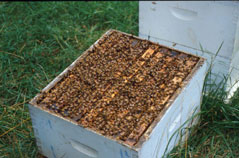
Rationale for IPM Program
Often, infected colonies look strong after the fall flow, and the application of an effective pesticide kills most of the mites present; however, the colony still collapses and dies over the next few weeks or months. Such colonies experienced significant, but less obvious damage while waiting for the fall treatment. The lesson is simple. One cannot assume that a colony will survive the winter if one waits until the end of the fall flow to apply a pesticide. Mite levels must be kept low during the summer in order that colonies can rear healthy workers during late summer and early fall.
For a colony to survive the winter in good condition, it must have a strong population of healthy worker bees in the fall (photo G). A colony exhibiting early stages of parasitic mite syndrome in mid-summer can usually be saved by the application of an effective miticide because it has time to produce several more generations of healthy workers in a low-mite environment. However, in the northeastern U.S., these symptoms often occur during or just prior to the fall nectar flow when chemical treatments are proscribed by label restrictions. By the time the flow is over, mite populations have increased dramatically and colonies have suffered severe damage. The result is a loss of colonies during the fall flow or shortly thereafter. This phenomenon is known as “fall collapse,” although it may occur in late summer, winter or whenever mite populations are allowed to increase to high levels.
